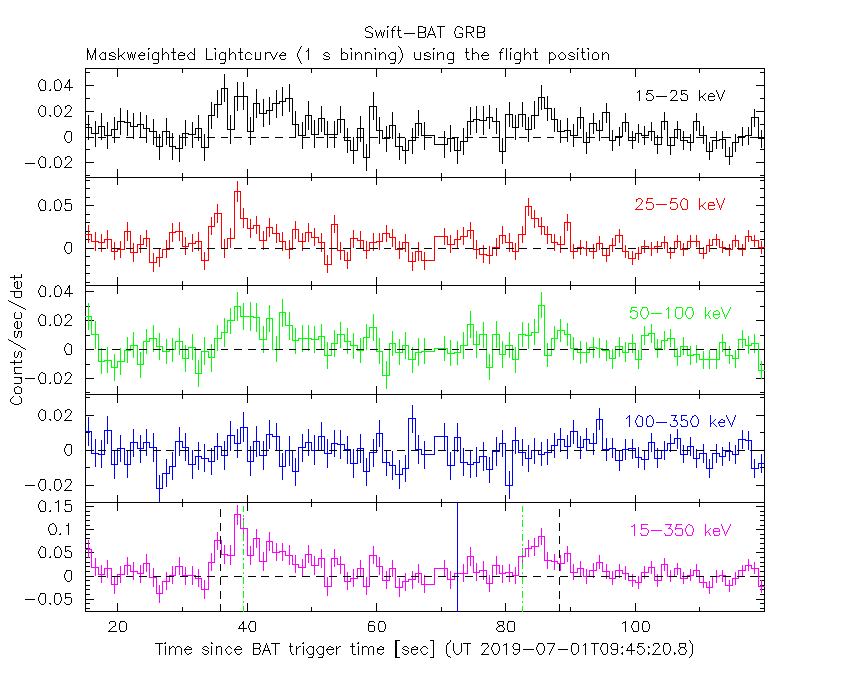
T.N. Ukwatta (LANL), E. Ambrosi (INAF-IASFPA) and M.H. Siegel (PSU) for the Swift team
At 09:45:20 UT, the Swift Burst Alert Telescope (BAT) triggered and located GRB 190701A (trigger=912310) (Ukwatta et al. GCN Circ. 24934). Swift slewed immediately to the burst. At the time of the trigger, the initial BAT position was 61° from the Sun (4.8 hours West) and 53° from the 3%-illuminated Moon. Table 1 contains the best reported positions from Swift, and the latest XRT position can be viewed at http://www.swift.ac.uk/xrt_positions.
Table 2 is a summary of GCN Circulars about this GRB from observatories other than Swift.
Standard analysis products for this burst are available at https://gcn.gsfc.nasa.gov/swift_gnd_ana.html.
As reported by Lien et al. (GCN Circ. 24973),
the BAT ground-calculated position is RA, Dec = 28.131, 58.899 deg which is RA(J2000) = 0
The mask-weighted light curve (Figure 1) shows a multi-peaked structure.
The main period of emission includes three broad peaks between roughly T+0 s and T+100 s, peaking about T+38 s.
The time-averaged spectrum from T+35.0 to T+90.0 s is best fit by a simple power-law model.
The power law index of the time-averaged spectrum is 1.91 ± 0.27.
The fluence in the 15-150 keV band is 8.7 ± 1.5 x 1
The results of the batgrbproduct analysis are available at https://gcn.gsfc.nasa.gov/notices_s/912310/BA/.
Analysis of the initial XRT data was reported by Ambrosi et al. (GCN Circ. 24961). We have analysed 16 ks of XRT data for GRB 190701A, from 144 s to 166.3 ks after the BAT trigger. The data comprise 10 s in Windowed Timing (WT) mode with the remainder in Photon Counting (PC) mode. The enhanced XRT position for this burst was given by Osborne et al. (GCN Circ. 24935).
The light curve (Figure 2) can be modelled with a series of power-law decays. The initial decay index is α=8.0 (+0.0, -0.9). At T+241 s the decay flattens to an α of 0.36 (+0.10, -0.18) before breaking again at T+7227 s to a final decay with index α=1.20 (+0.28, -0.20).
A spectrum formed from the PC mode data can be fitted with an absorbed power-law with a photon spectral index of 1.82 (+0.21, -0.13). The best-fitting absorption column is consistent with the Galactic value of 6.4 x 1
A summary of the PC-mode spectrum is thus:
Total column: 6.4 ± 1.1 x 1
Galactic foreground: 6.4 x 1
Excess significance: <1.6 σ
Photon index: 1.82 (+0.21, -0.13)
The results of the XRT team automatic analysis are available at http://www.swift.ac.uk/xrt_products/00912310.
The Swift/UVOT began settled observations of the field of GRB 190701A 145 s after the BAT trigger
(Siegel and Ukwatta GCN Circ. 24955).
No optical afterglow consistent with the enhanced XRT position (Osborne et al. GCN Circ. 24940) is detected in the initial UVOT exposures.
Table 3 gives preliminary
magnitudes using the UVOT photometric system
(Breeveld et al. 2011, AIP Conf. Proc., 1358, 373).
No correction has been made for the expected extinction in the Milky Way
corresponding to a reddening of

Figure 1. The BAT
mask-weighted light curve in the four individual and total
energy bands. The units are counts

Figure 2. The XRT light curve.
Any data from a crosshatched region are not included in the fit.
| RA (J2000) | Dec (J2000) | Error | Note | Reference |
|---|---|---|---|---|
| 0 |
+58°54'33.7" | 1.5" | XRT-final | UKSSDC |
| 0 |
+58°54'33.9" | 1.9" | XRT-enhanced | Osborne et al. GCN Circ. 24940 |
| 0 |
+58°53'56.9" | 2.4' | BAT-refined | Lien et al. GCN Circ. 24973 |
| Band | Authors | GCN Circ. | Subject | Observatory | Notes |
|---|---|---|---|---|---|
| Optical | Becerra et al. | 24946 | COATLI Optical Observations | COATLI | |
| Optical | Kumar et al. | 24954 | No candidates/counterpart in optical follow-up from GROWTH-India Telescope |
GROWTH-India | detection |
| X-ray | Setoguchi et al. | 24937 | MAXI/GSC detection | MAXI | detection |
| Filter | Exp(s) | Mag | ||
|---|---|---|---|---|
| whit |
145 | 295 | 147 | >20.3 |
| 303 | 553 | 246 | >19.8 | |
| white | 145 | 6776 | 727 | >21.2 |
| v | 629 | 11104 | 409 | >19.3 |
| b | 559 | 6570 | 432 | >20.6 |
| u | 303 | 6365 | 659 | >20.6 |
| w1 | 677 | 6160 | 432 | >19.9 |
| m2 | 652 | 5955 | 432 | >19.3 |
| w2 | 610 | 10926 | 1158 | >20.2 |
Table 3. UVOT observations reported by Siegel and Ukwatta (GCN Circ. 24955). The start and stop times of the exposures are given in seconds since the BAT trigger. The preliminary 3-σ upper limits are given. No correction has been made for extinction in the Milky Way.
July 4, 2019